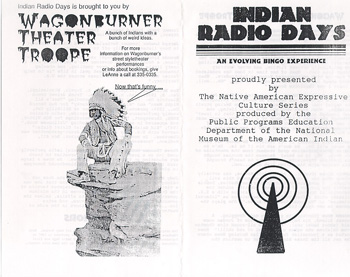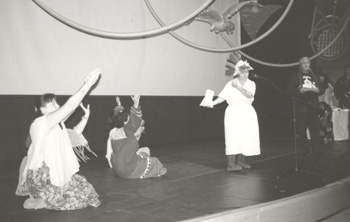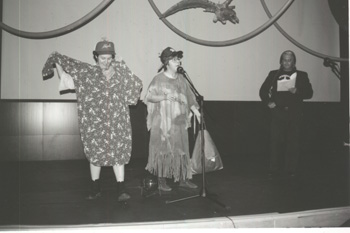
 Indian Radio Days
Indian Radio Days
by LeAnne Howe and Roxy Gordon
- Production
- Directed by Cameron Ulrich. Indian Bingo Lady played by Vanessa Short Bull. Performed in the Wayne S. Knutson Theatre in the Warren M. Lee Center for the Fine Arts at the University of South Dakota. October 25-29, 2000.
- Review
- Kay Humphries, “Indian Satire Is Unfamiliar to Some in Vermillion Audience.” Rev. of Indian Radio Days, by Roxy Gordon and LeAnne Howe. Indian Country Today, 8 Nov. 2000. Online. 9 Nov. 2000.
VERMILLION, S.D. – The sound of laughter filled the theater during the first performance of “Indian Radio Days,” a play celebrating the modern-day version of the American Indian oral tradition of storytelling.
The comedy written by LeAnne Howe and the late Roxy Gordon was performed in the Wayne S. Knutson Theatre in the Warren M. Lee Center for the Fine Arts at the University of South Dakota.
A diverse audience found themselves laughing and engaged as the actors and the play took them on a sophisticated satirical journey exploring the dark side of American history and the atrocities American Indians survived. It provokes thought about how American Indians will define their identity in contemporary society.
Using the format of a radio play, the actors, many of them novices on the stage, embraced their characters, seamlessly delivering a captivating performance.
Outrageously funny were the portrayals of the Indian Chief who greeted the Mayflower, the Indian Bingo Lady, Princess Wanna Buck, Kevin Costner and Jane Fonda.
Vanessa Short Bull, who played the Indian Bingo Lady, left people rolling in their seats as she enticed them, spinning yarns about how to win a bingo game. While Short Bull is no stranger to an audience, it was her first attempt at theater. The Oglala Lakota has performed as a ballerina and is Miss South Dakota, USA 2000.
She added much to her character by bringing some of the phases that might be heard on the Pine Ridge and Rosebud reservations to the stage.
The play engaged viewers even further through the audience. The theater-goers were encouraged to cheer the hero and boo the villain. Even a creative bingo game lured spectators closer to the characters.
There was a running joke about “Indian time” throughout as the announcer read the same time as he introduced each individual in the parade of characters.
Ulrich, who directed the play as part of the requirements for his master’s degree in fine arts, chose it because it offered a unique approach to the American Indian culture and he said he really enjoyed it when he read it.
“I loved it. I laughed and laughed. The first attraction to it was the humor because I looked at the traditional theater audience that may not have any exposure to Native people or culture. It did such a fine job of sharing what I think is one of the true treasures of our culture – its humor,” he said.
Laughter ceased in some theater seats as individuals struggled to grasp some of the humor. Others may have found some humor offensive. The play drew a similar response when it debuted in New York, Howe said.
The writer said she and Gordon thought the humor would be universal.
 “When we wrote it, we thought we were writing for a mainstream audience. We thought everyone knew Indian history. We thought everyone knew about the stupid ways we were caricatured in the mainstream media.”
“When we wrote it, we thought we were writing for a mainstream audience. We thought everyone knew Indian history. We thought everyone knew about the stupid ways we were caricatured in the mainstream media.” Usually when the play is performed in front of American Indian audiences, people can’t stop laughing, but a non-Indian audience doesn’t always find the humor very funny, she said.
“They don’t know what happened to the Mohawks. They don’t know what happened to the Menominees. They don’t know the fact we didn’t become citizens and if they don’t know we were code talkers, it goes right over their head. They don’t have a cultural handle,” she said.
Borrowing from the often erroneous portrayal of the American Indians in American history books and well-known stereotypes, the play pokes fun with a distinctly Southern flavor added to American Indian humor.
“We took those stereotypes of us and gave them a voice,” she said.
“I think there are a number of levels of humor that will reach people at different times which appeals to a general audience, but there is very Indian humor there that just reaches Indian people. You can hear it in their laughter,” Ulrich said.
When the play was performed at an Iowa university, a man who was writing his dissertation on Indian theater hated it. Howe said he found it offensive that she made fun of some of the elements of her own culture in the satire.
“I don’t know what anyone else was feeling. When the person next to me wasn’t laughing, it seemed like it wasn’t that they didn’t understand the play but they didn’t know the history,” said Richard Milda, an American Indian from Flandreau who sat in the front row with his young children.
“Even my son and my daughter were laughing. I think it is just being aware of the past and aware of what was done while being able to empathize.”
Lynette Melby, a non-Indian, said she came to the play for a greater understanding of the culture and it gave her a greater understanding of the boundaries of sensibilities.
“It was a relief to me to be able to see a sense of humor. This was a very different aspect of the culture and I enjoyed the humor.”
The play was just one of many stops for Howe who just finished giving a three-week theater workshop as an artist in residence at Sinte Gleska University on the Rosebud.
An enrolled member of the Choctaw Nation of Oklahoma, Howe has written plays, legal essays and film scripts for public television documentaries and fiction. Her short stories appeared in literary journals such as Story, Callaloo, Fiction International, and Cimmarron Review. This year, she will write the text for the permanent exhibit about Choctaw creation stories for the National Museum of the American Indian in Washington, D.C.
“I write plays for fun. I don’t do it that often. I write one every four years whether I need to or not, but I really consider my serious work my fiction,” she said.
She recently finished the novel, “Shell Shaker,” which she began writing in 1993 while she was on a research fellowship at the Smithsonian Institution. Still fielding offers from publishers across the nation, she expects the novel to be on the shelves next year.
Howe read parts of her novel to students to illustrate the finer points of writing well and bringing out the richness of a story.
One chapter detailed the daily lives of the Choctaw people and a tradition of blood sacrifice. “Let’s say someone committed a crime. Someone else can stand in for them,” she explained.
That chapter, set in 1738, is written from a mother’s point of view about the sacrifice of her life to spare that of her daughter wrongly accused of a murder.
“Like ‘Indian Radio Days,’ it has a whole community of Choctaw voices,” Howe said.
The 49-year-old writer majored in English at Oklahoma State University where she had set out to become a technical writer, but became a journalist. She worked at small newspapers in Texas, later moving to the Dallas Morning News. While honing her skills, she worked as a proofreader and eventually proved herself as a feature writer.
 Crediting an editor at the Dallas Morning News for nurturing her work, she said the newspaper business helped “me learn to craft better. I liked writing for newspapers, but it didn’t pay very much.”
Crediting an editor at the Dallas Morning News for nurturing her work, she said the newspaper business helped “me learn to craft better. I liked writing for newspapers, but it didn’t pay very much.” With her children approaching high school graduation, she left the newspaper to work on Wall Street as a bond saleswoman.
Writing is still her love and like many of her contemporaries, Howe had to be persistent to get publishers to publish her work.
She said American Indian writers faced decades of challenges to gain acceptance as part of the landscape of American literature. In the last 10 years authors whose works often reflected the hardships of American Indian life rather than tidy romantic legends enjoyed a renaissance, allowing the literature to emerge.
Three anthologies of American Indian plays are available and two others are in the works for publication by the University of Minnesota and UCLA, she said. “It has all happened in three years.
“I think for writers, playwrights and Indian actors there is a cycle. When I started writing really nasty little stories about Indian bars and growing up in Oklahoma City, nobody would publish my work.”
Publishers often rejected the realistic portrayal of contemporary life for urban American Indians, wanting more romantic stories.
“I started writing short stories. Maybe they weren’t very good, but they kept coming back saying, “Where’s the medicine?'”
Often American Indian literature, while filled with splendid imagery and a multitude of voices, leaves some mainstream readers reaching for transitional paragraphs to try to tie the stories together, she said.
The same might be said for audiences watching “Indian Radio Days,” because it requires the audience to think about the American Indian culture on many different levels.
Kay Humphrey reports from the Northern Great Plains.
